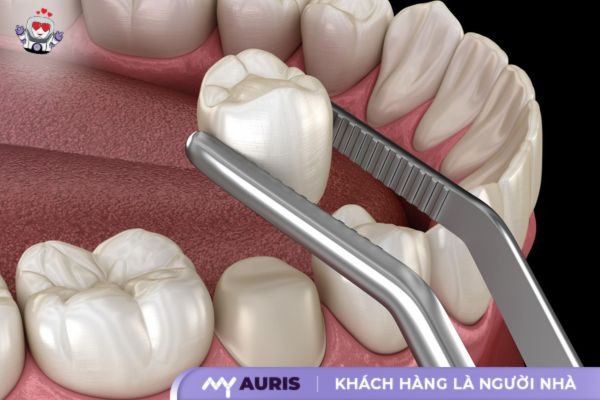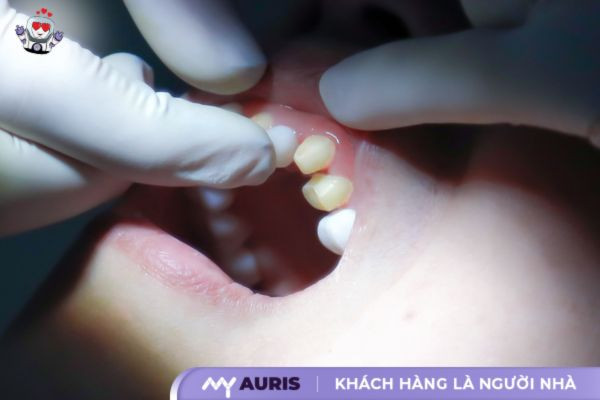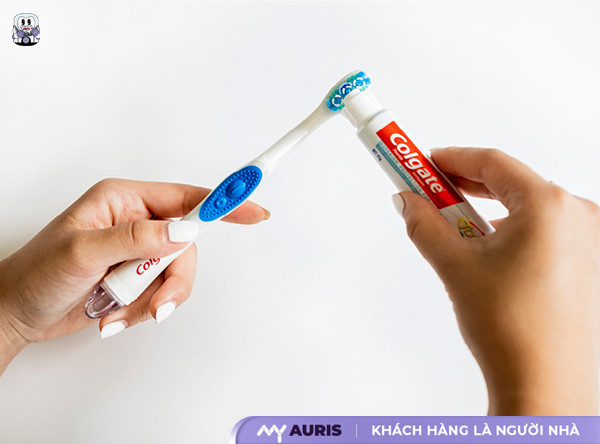Cosmetic porcelain veneers are the top choice for a confident smile. However, issues like dark gum lines and bleeding gums after veneers cause many people to hesitate, especially regarding whether to get veneers on just two front teeth. Don’t worry, with our professional experience, we will answer all your questions, helping you understand the process of getting veneers on two front teeth, its benefits and risks, as well as how to care for them to maintain a bright, long-lasting smile. Contact us now for a consultation!
What are veneers for two front teeth?
Getting veneers on two front teeth is a cosmetic dental solution chosen by many when front teeth have issues such as gaps, discoloration, chips, fractures, or even a slight protrusion of the two front teeth. This technique involves slightly grinding down the natural teeth to make room for a porcelain crown, which helps restore the natural shape and color of the teeth.
Currently, there are 3 popular types of porcelain veneers: glass ceramics, porcelain, and composite resin, all of which have colors and shapes similar to natural teeth and high durability. With their easy-to-care-for nature, porcelain false teeth also enhance smile aesthetics, while improving chewing ability and increasing the stability of the dental arch.
Veneers on two front teeth not only help users feel more confident in communication but also play a role in preventing teeth from shifting, which is especially important if adjacent teeth show signs of slight misalignment. Many people also confuse dental implants for front teeth with veneers. However, veneers differ in that they do not completely replace natural teeth, but only cover the outside, while dental implants are typically used when teeth are completely lost.

Outstanding benefits of getting veneers on two front teeth
Should you get veneers on two front teeth? The answer is yes – especially in cases where teeth are gapped, chipped, discolored, or irregularly shaped. Veneers on two front teeth not only help improve dental aesthetics but also bring many practical benefits to oral health.
Enhanced aesthetics
All-ceramic veneers have light-reflecting and refracting properties very similar to natural teeth. As a result, the color of the veneers will be natural and will not change over time, helping the smile become brighter and more confident. This is why many people choose veneers to improve the appearance of their front teeth.
High biocompatibility
Modern porcelain crowns, especially metal-ceramic crowns, possess electrical and chemical inertness, which effectively resists corrosion and does not cause allergies to soft tissues. This is an extremely important factor in ensuring biocompatibility and maintaining long-term oral health.
Protecting teeth and dental pulp
When teeth are decayed, cracked, or have been previously treated, veneers help reconstruct and protect the teeth from external stimuli such as hot and cold, thanks to the excellent insulating properties of porcelain. Porcelain crowns are designed to be strong, helping to evenly distribute chewing forces, limit fracture or collapse of teeth, and simultaneously reduce tooth sensitivity and prevent damage to the pulp.

How much do veneers for two front teeth cost?
The cost of veneers for two front teeth currently depends on the porcelain material and the aesthetic needs of each person. In the market, two main product lines are widely used: metal-ceramic veneers and all-ceramic veneers, each with different prices and characteristics.
Metal-ceramic veneers have a relatively low price, ranging from 1,500,000 – 2,500,000 VND/tooth. However, over time, the metal frame can experience metal oxidation, leading to black gum lines, reducing the aesthetic appeal of the teeth.
Conversely, all-ceramic veneers – which contain no metal components – are a more premium choice thanks to their natural tooth color, superior durability, and long-lasting beauty. In particular, the monolithic ceramic line minimizes the occurrence of black gums, providing a radiant, long-lasting smile. The price of all-ceramic veneers ranges from 3,000,000 – 12,000,000 VND/tooth, depending on the type of ceramic, the technology used, and the specific desires of the customer.
If you are wondering how much it costs to get veneers on two front teeth, visit My Auris Dental Clinic – a reputable address with a team of highly qualified doctors, modern equipment, and dedicated service.
Price list for 2 front teeth veneers at My Auris Dental Clinic
| Type of tooth | Cost |
| Metal-free Zirconia veneers (Germany) | ~ 1,500,000 – 3,000,000 VND/tooth
(Combo Price – 5-year warranty) |
| Vita USA veneers | ~ 2,500,000 – 4,500,000 VND/tooth
(Combo Price – 8-year warranty) |
| Cercon HT/ Nacera veneers | ~ 3,500,000 – 6,000,000 VND/tooth
(Combo Price – 10 to 15-year warranty) |
| Lava veneers | ~ 5,500,000 – 9,000,000 VND/tooth
(Combo Price – 20-year warranty) |
| Emax Press veneers | ~ 6,000,000 – 12,000,000 VND/tooth
(Combo Price – 25-year warranty) |
| Amira (Lisi) crystal veneers | ~ 8,000,000 – 14,000,000 VND/tooth
(Combo Price – 30-year warranty) |
| Lucy crystal veneers | ~ 10,000,000 – 16,000,000 VND/tooth
(Combo Price – Lifetime warranty) |
| Irisa Orodent high Translucent crystal veneers | ~ 12,000,000 – 20,000,000 VND/tooth
(Combo Price – Lifetime warranty) |
| Endora diamond crystal veneers | ~ 15,000,000 – 30,000,000 VND/tooth
(Combo Price – Lifetime warranty) |
Standard dental procedure for front teeth veneers
Front teeth veneering, especially when you need to veneer two teeth, requires a precise procedure to ensure long-term effectiveness and optimal aesthetic results. Below are 5 standard steps applied by reputable clinics:
Step 1: General examination and personalized consultation
Before starting the veneering process, the dentist will conduct a comprehensive examination of your front teeth and overall oral health. Issues such as gingivitis or periodontitis, if detected, will need to be treated beforehand. This is a crucial step to ensure safety and effectiveness for subsequent steps.
Step 2: Anesthesia, disinfection, and gentle tooth preparation
After cleaning and disinfecting the oral cavity, the dentist will administer local anesthesia to ensure you feel no pain or sensitivity. Next is the tooth preparation step, performed meticulously at a reasonable ratio, preserving natural tooth structure while ensuring proper adhesion for the porcelain crown later.
Step 3: Taking tooth impressions
The dentist will take tooth impressions using specialized material, then send them to the Lab for fabrication of the porcelain veneers. Thanks to the application of modern CAD/CAM technology, the porcelain crown will be precisely designed according to the dental arch, ensuring a perfect fit and natural appearance.
Step 4: Cementing the porcelain crown and adjusting the bite
Once the porcelain crown is complete, the dentist will permanently cement it onto the prepared front tooth. This process requires careful checking of the bite to ensure comfortable chewing, and adjusting the color to match the natural teeth.
Step 5: Regular check-ups and follow-up after veneers
Upon completion, you will be scheduled for follow-up appointments so the dentist can check the stability of the front tooth veneers, and detect and promptly address any issues that may arise. This helps ensure your two front teeth veneers remain beautiful and durable over time, maintaining optimal chewing function and aesthetics.

Important notes after getting veneers on two front teeth
Getting veneers on two front teeth not only helps improve the aesthetic appeal of your smile but also enhances chewing function. However, to extend the lifespan of your veneers and maintain long-term effectiveness, you need to pay attention to proper veneer care and oral hygiene.
Avoid dark-colored foods and drinks: Within the first 1-2 weeks after getting veneers, limit tea, coffee, red wine, etc., as they can stain the veneer surface.
Limit overly hard or excessively hot/cold foods: Foods like ice, hard candy, or very hot food can easily chip or crack veneers or affect your natural teeth.
Proper oral hygiene: Brush your teeth at least twice a day with a soft-bristled toothbrush. Use a water flosser and dental floss to clean plaque and prevent gum inflammation.
Pay attention to teeth grinding habits: If you grind your teeth while sleeping, you should use a night guard as instructed by your dentist to prevent wear or cracking of your veneers.
Attend regular follow-up appointments and adhere to your dentist’s instructions. Thorough care will help maintain the beauty and durability of your veneers and ensure long-lasting aesthetic results.





